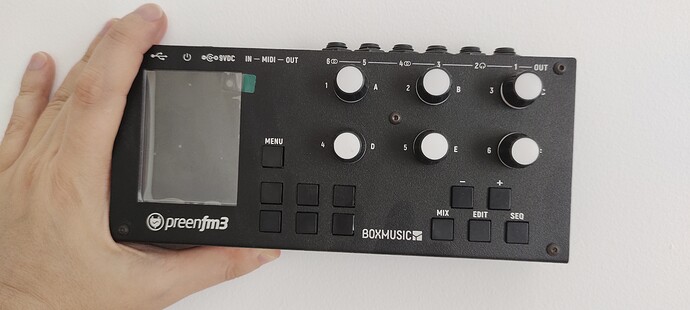Relevant and might be of interest -
I’ve seen this, but IMO it isn’t a relevant comparison. TX 81z = 4 op 8 part multitimbral, while Mega FM has DX7 architecture i.e. 6op mono-timbral,
Are u sure about that?
The MEGA is based on the notorious chip used in the Sega Megadrive, the YM2612. It’s 4-op, 6 voices if I remember correctly.
Ym2612 is 4op and the original chip is capable of 6 channels of multi-timbrality. It’s a good comparison, and it’s pretty cool he was able to use the mega to control all the parameters of the tx by converting the cc to sysex
Opsix - cool and versatile but sounds a bit weird scooped to me
FB01 - great sound, fun, multitimbral, cheap but not really programmable from the unit itself
The Mega FM is defs not multi-timbral, let alone 6 part. Would be interested if it were. It has 32 voices
- 4 Voicing modes (Poly12, stereo/wide6, special CH3 mode, 12 voice unison with detune/fat knob
I stand corrected. 4op with 8 algos on the Mega FM.
EDIT. The TX 81z has the YM2414B chip, whereas the Maga FM has a Ym2612 did Yamaha put the latter in any of their synths, or was it a cheap derivation to cash in on their development?
When using the 4 outputs, there will be no effects on them from Digitone… just to know.
DX7 is a synth that gave everything in the 80s: in those days all the great artists were committed to bringing out the best out of it, I don’t think today it could still deliver anything new (unless you’re after that retro sound). The sound of DX7 is claustrophobically 80’s: that’s the limit I’m talking about .
Obviously, this is my personal opinion, I could also be wrong. If you use DX7 to play 2023 music please post it here, I’d be interested to hear it
I’m not sure where you’re getting 32 voices? Each 2612 has 6, and it looks like the MEGA stacks two of them for a total of 12 voices.
Each of those could be it’s own unique timber (indeed, Genesis games would be pretty boring were that not the case) but the MEGA seems to force each voice to the same patch — probably for ease of programming and because polyphony is more important in a desktop synth? But that’s a firmware decision, not a limitation of the chip.
It was used in the FM-towns, the Megadrive/Genesis, and (in a repackaged form) in a number of Sega arcade cabinets.
I don’t believe it was ever used by Yamaha in anything, most likely due to that busted on-board DAC.
The Mk2 of the megaFM uses the YM3438 variant, which is basically the same except is has an improved DAC so is louder/less noisy and has a different character. Don’t know if any other synths used it.
Erroneous recollection of the specs on my part! It has 32 sliders.
I had, and loved, the TX81Z. A great synth, but you’ll have to put in the time with it. Really good for experimental sounds, as well as that classic bass.
I still have an old SY77 in the basement, in need of a new battery. Also a lot of the tact switches need to be replaced. But it still sounds wonderful (or would if it had a battery that is). Great keybed too. Takes up a bit too much space though.
The TQ5 has been at the heart of my setup for many years. The 8-part multi mode is a ton of fun - you can even edit the first one with SysEx as the other parts are playing!
Couldn’t do without this editor/librarian (works great with Wine if you don’t have a Windows machine): TX81Z Programmer Homepage
That being said, these past few weeks I’ve been playing with a friend’s Digitone and unsurprisingly it’s excellent at the same types of sounds, although I still somewhat prefer the dirty character of a Yamaha 4-OP.
What chips does the PreenFM use? Were they in other synths?
I’m not sure but Preenfm based on atmega. It’s open source project. 2nd version have a 4 chanels multitembral and 3rd version have a 6 chanel with splits outputs.
I generally try not to get in the weeds about converters and other audiophile foolishness, but out of the two OpSixes I’ve owned, they were both congested in the lower mids / upper bass with a weird plasticky scoop in the midrange. It’s not the engine itself, since the VST doesn’t seem to have this problem.
My Digitone, DX7ii and even the FM in the System 8 all sounded much cleaner and richer with top end harmonics. I guess when you are actually mixing a song these things can be fixed with some EQ and effects… but yeah it’s output stage sounds pretty bad compared to nearly any other synth I’ve owned.
One of my recent favorite performances with vintage fm gear, never seen 3 tq5s together before!



![PreenFM2 Multitimbral Jam [Live Techno]](https://img.youtube.com/vi/ufDTOc9Fyd8/maxresdefault.jpg)